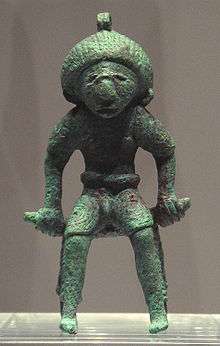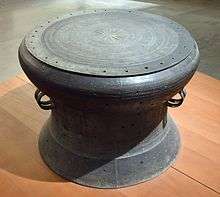Đông Sơn culture
| Prehistoric and ancient cultures of Vietnam |
|---|
| Paleolithic |
| Sơn Vi culture (20,000–12,000 BC) |
| Mesolithic |
| Hoabinhian (12,000–10,000 BC) |
| Neolithic |
| Bắc Sơn culture (10,000–8,000 BC) |
| Quỳnh Văn culture (8,000–6,000 BC) |
| Đa Bút culture (4,000–3,000 BC) |
| Bronze Age |
| Phùng Nguyên culture (2,000–1,500 BC) |
| Đồng Đậu culture (1,500–1,000 BC) |
| Gò Mun culture (1,000–800 BC) |
| Dong Son culture (1,000 BC–100 AD) |
| Iron Age |
| Sa Huỳnh culture (1,000 BC–200 AD) |
| Óc Eo culture (1–630 AD) |
The Đông Sơn culture (literally "East Mountain culture", but from the name of Đông Sơn village) was a Bronze Age culture in ancient Vietnam centered at the Red River Valley of northern Vietnam from 1000 BC until the first century AD.[1]:207 It was the last great culture of Văn Lang (as Vietnam was known then) and continued well into the next Vietnamese state of Âu Lạc. Its influence spread to other parts of Southeast Asia, including Maritime Southeast Asia, from about 1000 BC to 1 BC.[2][3][4]
The Đông Sơn people, who are also known as Lạc or Lạc Việt, were skilled at cultivating rice, keeping water buffalos and pigs, fishing and sailing in long dugout canoes. They also were skilled bronze casters, which is evidenced by the Đông Sơn drums found widely throughout northern Vietnam and Southern China.
To the south of the Đông Sơn culture was the proto-Cham Sa Huỳnh culture.
Origins


The origins of Đông Sơn culture may be traced back to ancient bronze castings. The traditional theory is based on the assumption that bronze casting in eastern Asia originated in northern China. However, according to archaeological discoveries in north-eastern Thailand in the 1970s, the casting of bronze began in Southeast Asia first.[5] The Đông Sơn bronze industry has a local origin, equivalent in timing to the Go Mun culture, 700-500 BC. This includes bronze axes, spearheads and knives. This was followed by daggers, swords, drums, and situla from 500-0 BC. Finally, Chinese seals, coins, mirrors and halberds appear in the first century AD.[1]:207
The bronze drums were used for war, "the chief summons the warriors of the tribe by beating the drum", when mourning, and during feasts. "The scenes cast onto the drums would inform us that the Dong Son leaders had access to bronze founders of remarkable skill." The Lost-wax casting was based on Chinese founders, but the scenes are local, including drummers and other musicians, warriors, rice processing, birds, deer, war vessels, and geometric designs.[1]:200–202
The bronze drums were made in significant proportions in northern Vietnam and parts of southern China in Yunnan. The Đông Sơn bronze drums exhibit "remarkable skill". The Co Loa drum weighs 72 Kg, and would have required the smelting of between 1 and 7 tonnes of copper ore.[1]:200
See also
References
- 1 2 3 4 Higham, C., 2014, Early Mainland Southeast Asia, Bangkok: River Books Co., Ltd., ISBN 9786167339443
- ↑ Vietnam Tours
- ↑ Nola Cooke, Tana Li, James Anderson - The Tongking Gulf Through History - Page 46 2011 -"Nishimura actually suggested the Đông Sơn phase belonged in the late metal age, and some other Japanese scholars argued that, contrary to the conventional belief that the Han invasion ended Đông Sơn culture, Đông Sơn artifacts, ..."
- ↑ Vietnam Fine Arts Museum 2000 "... the bronze cylindrical jars, drums, Weapons and tools which were sophistically carved and belonged to the World famous Đông Sơn culture dating from thousands of years; the Sculptures in the round, the ornamental architectural Sculptures ..."
- ↑ Taylor, Keith W. (1991). The Birth of Vietnam. University of California Press. p. 313. ISBN 0-520-07417-3.
Austronesian vernacular architecture and the Ise Shrine of Japan: Is there any connection? Link
by Ezrin Arbi Department of Architecture Faculty of Built Environment University of Malaya.External links
- Đông Sơn culture (photo collection)
 Media related to Drum from Selayar at Wikimedia Commons
Media related to Drum from Selayar at Wikimedia Commons- Drums from Selayar (photo collection)
| Wikimedia Commons has media related to Đông Sơn culture. |
